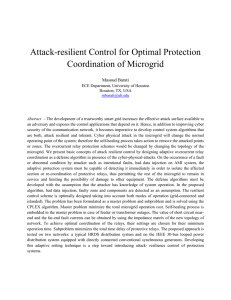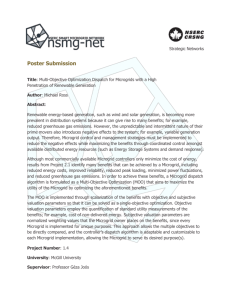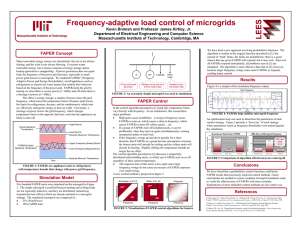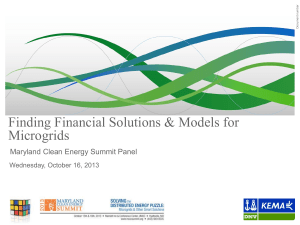A Methodology to Optimize Benefits of Microgrids
advertisement
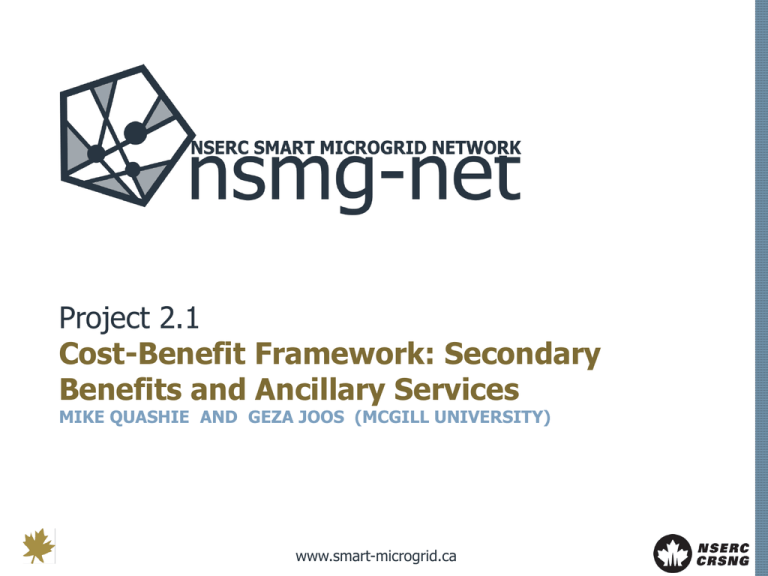
Project 2.1 Cost-Benefit Framework: Secondary Benefits and Ancillary Services MIKE QUASHIE AND GEZA JOOS (MCGILL UNIVERSITY) www.smart-microgrid.ca Presentation outline • • • • • Problem Identification Proposed Solution Methodology Results and Conclusion Future work and collaboration Problem Identification • Microgrids are often touted as a technology that can improve local system reliability and aid in the integration of renewable energy resources. However, to facilitate the additional control and operating modes associated with a Microgrid, additional equipment is needed. – The cost associated with this infrastructure can be quantified once the necessary elements are identified. – Contrarily, there may be certain costs, such as those associated with changes to operating protocol, training and new safety requirements, which may be more difficult to translate into a dollar figure. – For utilities and business owners, this analysis is required to develop the business case for a given technology. • Many of the benefits of a Microgrid are also not tangible in the Canadian context and consequently require additional considerations to monetize. • How can the assumptions made in the cost-benefit framework be tested? Solution • Previous work done in collaboration with CanmetEnergy and project 1.4, identified benefits of Microgrids and how the benefits impacts stakeholders. • Benefits Identified: Technical: Network efficiency improvement(losses reduction), reliability improvement Economic: cost of energy Environmental: GHC emission reduction • The natural step that follows is to developed a methodology to optimize the identified benefits. Historical data of wind speed and solar irradiance were obtained from CWEEDS through interaction with CANMET ENERGY. Methodology • The work done over the year is proposes a generalized methodology to determine the optimal configuration of microgrids that maximizes its benefits. HOURLY SOLAR OUTPUT 0.06 0.09 0.05 0.08 0.07 0.06 0.05 0.04 0 Winter Spring Summer Fall 5 10 15 Hours 20 25 HOURLY OUTPUT IN PER UNIT (P.U) HOURLY OUTPUT IN PER UNIT (P. U) HOURLY WIND POWER OUTPUT 0.1 Winter Spring Summer Fall 0.04 0.03 0.02 0.01 0 0 5 10 15 HOURS 20 25 Methodology • The technique proposed herein, incorporates a probabilistic modeling of variable loads and distributed generators into a deterministic power flow problem to solve an optimization problem 𝑝 min 𝐹 = ML t, n, µ, σ + GCC t, n + GHC(t, n) (1) 𝑛=1 Subject to: 𝑃𝐺,𝑗 − 𝑃𝐿𝑜𝑠𝑠,𝑗 t, n, µ, σ + 𝑃𝑊,𝑗 t, n, µ, σ + 𝑃𝑆,𝑗 t, n, µ, σ = 𝑃𝐿𝑜𝑎𝑑,𝑗 t, n 𝑃𝑊,𝑗 t, n, µ, σ + 𝑃𝑆,𝑗 t, n, µ, σ ≤ 𝑃𝑝𝑒𝑛,𝑗 × 𝑃𝐿𝑜𝑎𝑑,𝑗 t, n (2) (3) • The losses (PLOSS) from the power flow problem is monetized and supplied to the objective function as one of its input multiple cost functions ML t, n, µ, σ = 𝑃𝐿𝑂𝑆𝑆 t, n, µ, σ × CP (4) Methodology • For GCC: 𝐺𝐶𝐶 𝑡, 𝑛 = 𝑃𝐺 ∗ 𝐶𝑃 + 𝑃𝑊,𝑗 t, n, µ, σ ∗ 𝐶𝑃𝑊 + t, n, µ, σ ∗ 𝐶𝑃𝑃𝑉 (5) 𝐶𝑅𝐹 = 𝑟(𝑟+1)𝑦 𝑟(𝑟+1)𝑦 −1 (6) (7) 𝐴𝐶 = 𝐶𝑅𝐹 × (𝐶𝐶 − 𝑑𝑖𝑠𝑐𝑜𝑢𝑛𝑡𝑒𝑑 𝑆𝑉) 𝐴𝑉𝐶 = 𝐴𝐶($/𝑦𝑒𝑎𝑟) 𝐴𝑛𝑛𝑢𝑎𝑙 𝐸𝑛𝑒𝑟𝑔𝑦 (𝐾𝑊ℎ/𝑦𝑒𝑎𝑟) (8) • For GHC: 𝐸𝐶 = 𝑃𝐺 × 𝑒𝑚𝑖𝑠𝑠𝑖𝑜𝑛 𝑡𝑜𝑛𝑠 𝑘𝑤ℎ × 𝑐𝑎𝑟𝑏𝑜𝑛 𝑡𝑎𝑥 $ 𝑡𝑜𝑛𝑠 (21) • The optimization problem then concatenates the monetized losses, monetized emission and the cost components of generation into a single objective and then minimizes it. Test System Peak load of 12.775MW. The optimal configuration was also found to be 1.2 MW of wind turbine on node 7 and 30 KW solar panel on node 4. Figure 1. Cigre's North American medium Voltage DistributionNetwork Benchmark with DG connected to operate as Microgrid .(CIGRE TF C6.04.02, “Benchmark systems for network integration of renewable and distributed energy resources,” technical brochure, version 21, pp25-39, August 2010.) RESULTS COST OF ENERGY TO THE DISTRIBUTION SYSTEM OPERATOR 0.06 A 16.1 percent decrease in the average cost of energy for the optimal case is observed in comparison to the base case 0.058 COST OF ENERGY(S/KWh) 0.056 0.054 0.052 0.05 0.048 0.046 0.044 0.042 0.04 Base Case Optimal Case 0 10 WINTER 20 30 SPRING 40 50 HOURS 60 SUMMER 70 80 90 100 FALL Figure 2. Comparison of Hourly Total Cost of Energy to the Distributed Network Operator for a Year (each 24hr represents a Season) Results Average Losses(MWper hr) Seasons Winter Spring Summer Fall Annual(MWh) 0.6743 243.1123 0.6605 238.1372 0.6082 218.4336 0.6078 218.3088 I. Base Case(No DG) 0.6757 0.6743 0.6770 II. Solar Only 0.6620 0.6605 0.6631 III. Wind Only 0.6037 0.5992 0.6160 IV. Wind and Solar 0.6035 0.5988 0.6155 TABLE I. LOSSES IN THE POWER NETWORK FOR VARIOUS SCENARIOS The efficiency of the network is also improved by 10 percent through loss minimization for the optimal case in comparison to the base case. Conclusion • Application of the methodology to the microgrid planning process resulted in significant decrease in the cost of energy to the distribution network operator. • A significant improvement in the network’s efficiency (loss minimization) as well as reduction in CO2 emissions is also observed in applying the methodology to the microgrid planning process. • The economic, technical and environmental benefits of the microgid which are maximized through the use of the proposed methodology help offset the cost associated with microgrid’s implementation, building a better business case for microgrid advancement • Results of the study was present at Power and Energy Society general meeting 2013 in Vancouver. Future work • Develop a framework for implementing and quantifying ancillary services . • Application of the methodology to Microgrid demonstrations in existing and potential Microgrids (commercial, industrial and remote community settings). Potential collaboration with project 2.4 and 1.4 • Future collaboration with 3.1 to have an accurate estimate of ICT infrastruture in Microgrids






